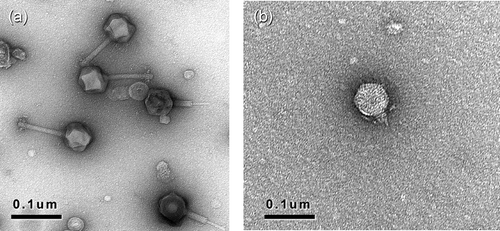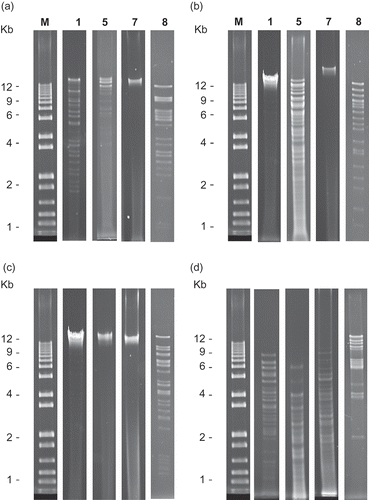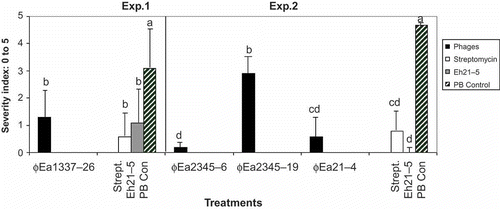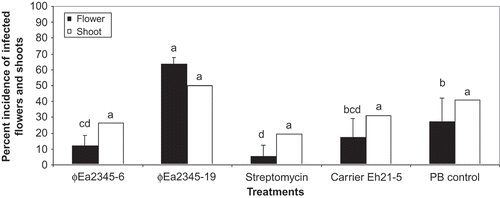Figures & data
Table 1. Origin and sources of Erwinia amylovora (Ea), Pantoea agglomeransa (Eh, Pa) and Pseudomonas fluorescens (Pf) isolates used in this study
Table 2. RFLP grouping, origin, morphotype with dimensions, PCR characterization and estimated genome size of the eight BC bacteriophages and phage ΦEa21-4 from Vineland, ON
Table 3. Host range of eight BC bacteriophages and ΦEa21-4 from Vineland, ON on 20 BC E. amylovora isolates, one E. amylovora from Michigan Ea110, Pantoea agglomerans a Eh21-5 and Pa2092 and Pseudomonas fluorescens Pf1100-6 by using the soft agar overlay method
Fig. 1. Electron micrographs of representative phages belonging to a, Myoviridae in a contracted and uncontracted state (Φ1598-6); and b, Podoviridae (Φ1337-26).

Fig. 2. Agarose gel electrophoresis of restriction patterns representative of those exhibited by four phage groups: RFLP groups 1, 5, 7 and 8: a, digestion with EcoRI; b, digestion with BglII; c, digestion with BamHI; and d, digestion with MvnI. Individual lanes are labelled as follows: M: 1 kb Plus DNA ladder (Qiagen), labels 1, 5, 7 and 8 indicating the phage group the pattern represents.

Fig. 3. Evaluation of phage control of fire blight infection on detached pear blossoms. The rating scale of 0 to 5 was used where 0: no symptoms and 5: infection spread on entire flower surface. In experiment 1, phage ΦEa1337-26 was tested against Erwinia amylovora Ea1337; and in experiment 2, ΦEa2345-6, ΦEa2345-19 and ΦEa21-4 were tested against E. amylovora Ea2345. In both experiments, phages were applied with the carrier Pantoea agglomerans Eh21-5. Each phage carrier combination was compared with streptomycin, Eh21-5 in phosphate buffer (PB), and PB alone (negative control). The severity index of three replications of five detached flowers was averaged and the data from three trials (experiment 1) and two trials (experiment 2) were pooled. Bars of each experiment with the same letters are not significantly different (P ≤ 0.05) according to Waller–Duncan k-ratio (k = 100) t test.

Fig. 4. Per cent incidence of infected flower clusters and vegetative shoots on potted apple trees in a screenhouse treated with ΦEa2345-6 and ΦEa2345-19 and Pantoea agglomerans Eh21-5. The trees were inoculated with a mixture of E. amylovora Ea1337 and Ea2345. Clusters displaying symptoms of fire blight indicated by blackening and wilting were recorded 8 d (flowers) and 20 d (shoots) following inoculation. The data were arcsine transformed for analysis. Bars of the same data set with the same letters are not significantly different (P ≤ 0.05) according to Waller–Duncan k-ratio (k = 100) t test.
